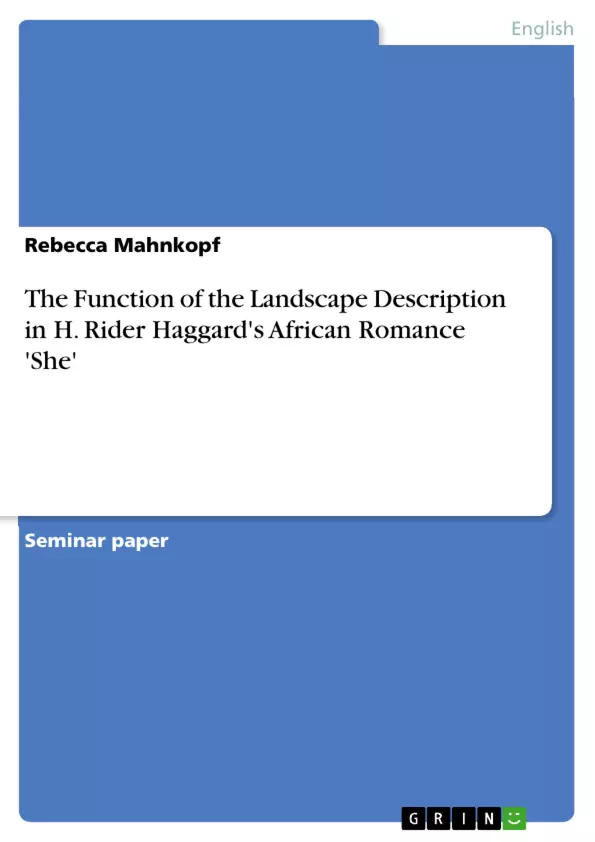The description of landscape has a central place in Henry Rider Haggard’s writing of Africa. In his romances he achieved symbolical journeys into the land and its past. In that way he gave his books their power and popularity.
But what are the peculiarities of his African landscapes? How has he constructed them? And what are their functions?
In my term paper I am going to have a detailed look at these questions. I am going to start with an overview of the European image of Africa in the 18th and 19th century and how this had an influence on Haggard’s writing. My next section deals with Haggard’s stays in South Africa and how he converted these first-hand experiences in his romances. Then I am going to deal with the characteristic elements Haggard uses in order to draw his African landscape. Then follows an analysis of one of his most famous romances, “She”, according to these elements. Can all of them be found within the story?
My last point is a summary of my individual results and I am going to draw a conclusion in which I try to answer the questions asked above.
Inhaltsverzeichnis (Table of Contents)
- Introduction
- The Image of Africa in Europe during the 18th and 19th Century
- H. Rider Haggard's First-hand Experiences in Africa
- The Landscape Description in “She”
- The concept of the “Mental Landscape”
- Analysis of particular characteristic elements of Haggard's landscape in “She”
- Africa as vast Eden
- Africa as wilderness
- Africa as dream underworld
- Africa as sexualised bodyscape
- Africa as home to ancient white civilisations
- Conclusion
Zielsetzung und Themenschwerpunkte (Objectives and Key Themes)
This term paper aims to analyze the landscape descriptions in H. Rider Haggard's African romance "She," exploring their construction and function within the narrative. It examines the influence of European images of Africa, Haggard's personal experiences, and the concept of the "Mental Landscape" on the author's depiction of the African landscape.
- European perception of Africa during the 18th and 19th centuries
- Haggard's personal experiences in Africa and their influence on his writing
- The concept of the "Mental Landscape" and its application in Haggard's portrayal of Africa
- The analysis of characteristic elements in Haggard's landscape descriptions in "She"
- The function of landscape descriptions in shaping the themes and power of Haggard's writing
Zusammenfassung der Kapitel (Chapter Summaries)
The introduction provides a general overview of the term paper's focus on landscape descriptions in H. Rider Haggard's writing, particularly "She." Chapter 2 examines the European perception of Africa during the 18th and 19th centuries, highlighting the influence of exploration, colonialism, and artistic representations. Chapter 3 explores Haggard's personal experiences in Africa, particularly his first-hand encounters with the landscape, which shaped his writing.
Chapter 4 delves into the specific elements of Haggard's landscape descriptions in "She," analyzing how he utilizes imagery to represent Africa as a vast Eden, a wilderness, a dream underworld, a sexualized bodyscape, and a home to ancient white civilizations.
Schlüsselwörter (Keywords)
This term paper focuses on key terms such as landscape description, African romance, "She," H. Rider Haggard, mental landscape, European perception, colonialism, exploration, first-hand experiences, and the construction and function of narrative elements in shaping themes and reader experience.
- Quote paper
- Rebecca Mahnkopf (Author), 2005, The Function of the Landscape Description in H. Rider Haggard's African Romance 'She', Munich, GRIN Verlag, https://www.grin.com/document/189406



